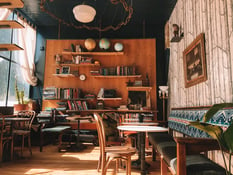Restaurants got absolutely whacked in 2020. More than 110,000 of them closed. The ones that didn’t had to reinvent themselves with contactless pickup, pop-up outdoor dining, and creative merchandising. The industry overall lost something on the order of $250 billion, by the count of the National Restaurant Association — more than a quarter of what the industry was expected to earn in 2020.
In short, restaurant operators were due for a break when the $1.9 trillion American Rescue Plan Act passed in March. They got a big one. Inside the historic relief bill is the Restaurant Relief Fund, or RRF, which earmarks $28.6 billion specifically for restaurants. Beginning in April, the Small Business Administration (SBA) says, the government will be shoveling that money out the door.
If you’re going to apply for those funds, speed is of the essence. Sean Kennedy of the National Restaurant Association crunched the numbers and noticed that while $28.6 billion is a gigantic amount of money, it’s only a fraction of what it would take to make the industry whole, telling Bloomberg Government that “demand for relief is probably going to outstrip the supply of the Restaurant Revitalization Fund.”
Anyone with a restaurant affected by Covid-19 should get moving to be ready with tax documents and paperwork. When the SBA gives everyone the green light, the money’s going to go fast. Here’s what you should know if you want to get part of the RRF.
Who can get Restaurant Revitalization Fund grant money?
The law casts a wide net for food and beverage establishments and favors smaller operators.
Per the language in the law, you’re eligible if you are a “restaurant, food stand, food truck, food cart, caterer, saloon, inn, tavern, bar, lounge, brewpub, tasting room, taproom, licensed facility or premise of a beverage alcohol producer where the public may taste, sample, or purchase products, or other similar place of business in which the public or patrons assemble for the primary purpose of being served food or drink.”
The restrictions to that very inclusive list are that you can’t be located in a government-run facility, you can’t have more than 20 locations, you can’t be publicly traded, and you can’t have a pending application under the “Save Our Stages” relief package for venues.
So, again, if you’re a small operator of a food and drink space, this bill is aimed at you. Businesses owned by women or by veterans will get priority.
If you got federal money through the Payroll Protection Program already, that won’t make you ineligible, but it might reduce the amount of your grant.
How much money can a restaurant get under the RRF?
The maximum awards will be $5 million for individual restaurants and $10 million for restaurant groups. Ultimately the amount determined by a formula that compares what you made in 2019 against what you made in 2020.
The RRF designates different levels of funding for restaurants with gross sales over and under $500,000, so if you're on the small side, you won't be competing directly against bigger establishments.
What does a restaurant relief grant cover?
Without using the phrase “everything but your restaurant marketing,” the act essentially says as much. If you spent money on the following during the pandemic, you can claim it:
Payroll for employees making under $100,000 and paid sick leave
Mortgage, rent, utilities, maintenance, and outdoor seating construction
Supplies, including those to protect and clean
Normal food and beverage expenses, and certain supplier costs
Operational expenses
Other expenses that were “essential to maintaining” your business, as determined by the SBA
How to apply for the restaurant relief grants
The very short answer here is, this might be an area where your accountant or business manager earns their fees. The longer answer is longer. You’re going to be getting money directly from the federal government, so there are some hoops and jumping involved.
As of March 30th, the SBA advised that restaurants no longer need to apply for a nine-digit Data Universal Numbering System number (a "DUNS number") in order to apply for restaurant relief. You also won't have to register on SAM.com, the government’s System for Award Management. So that's great!
If you weren’t open in 2019, you can still apply. You’ll simply need to show proof of the expenses you want the grant to cover. If you were open for just part of 2019, you can use your average monthly expenses to extrapolate annualized expenses.
[Photo by Karolina Grabowska from Pexels]





